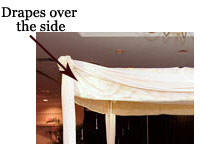Under the Skies of Blue
All you really need for a Jewish wedding is four poles and a sheet. Let’s talk a little about this canopy we call Chuppah. The Chuppah, as you probably already know, serves as a symbolic house into which the groom and the bride step into to start their ‘real’ house. A symbolic house was originally used instead of a real house so as not embarrass the groom who couldn’t afford a house of his own, and since the real estate boom took most young couples out of the real estate market this custom seems as appropriate as ever. It could also be, however, that the reason why the new couple is not able to afford a ‘real’ house is because they just spent the money for the downpayment on their wedding. But I digress. The Chuppah, the symbolic house, is open on all four sides to recall the tent of Avraham and his kindness which was open on all four sides to make sure that none of the passers by are turned away. Another connection with Avraham is to have the Chuppah outside, under the stars, (and here you thought outdoor Chuppahs were only for looks) to recall the blessing that was given to Avraham that his children will be like the stars. Though the primary reason to have the Chuppah outdoors would be that if it is to symbolize a house it should be outside. The Sephardic custom, however, is to hold the Chuppah ceremony inside, while most Orthodox people settle for a small patch of sky peeking in through the skylight. The custom by most Chassidic weddings is to have the Chuppah outside shine, rain, or snow. Second marriage ceremonies are usually held indoors.
 Some prefer for the cloth on top of the poles to drape over the sides to serve as mini-walls in this symbolic house just like in a real one. Most of these details, however, are preferences and do not disqualify the Chuppah ceremony.
Some prefer for the cloth on top of the poles to drape over the sides to serve as mini-walls in this symbolic house just like in a real one. Most of these details, however, are preferences and do not disqualify the Chuppah ceremony.
The Sephardic practice to have the Chuppah inside stems from the fact that in their understanding a Chuppah is not a house at all but rather a garment, a cloth with which the groom clothes his new wife displaying his newly acquired responsibilities to provide for his wife. This cloth also symbolizes Divine light that surrounds the new couple as it is said: ‘He wraps Himself in light as with a garment’ (Psalms 104:2).
There was a beautiful and quite interesting tradition in the city of Betar (before it was so violently destroyed by the Romans after the revolt of Bar Kochba) that when a child was born trees would be planted which would later be used as poles for the Chuppah on his wedding day. (Made in Heaven, pg 143 note 49) The symbolism here is somewhat perplexing. Perhaps it has something to do with the concept of Bashert, i.e. the Talmud says that 40 days prior to the formation of the child in his mothers womb his destiny is decreed from above. One of the things that are mentioned there as being predecreed is the person’s spouse. Perhaps the trees showed the connection between birth and matrimony.
There are many deeper, more sublime ideas represented by the Chuppah and these are for the Kabbalists to ponder. What’s important for us is to absorb the rare (once in alifetime) moment of standing wrapped up within these ideas, within these symbols.
The great things about symbols is that they stretch with the ability of people to appreciate them. Aesthetics are of value only in the eyes of humans who are able to perceive the hinted within the revealed. Regardless of the physical attributes of your Chuppah, the decorations or the lack of them, you have the power to fill it up, to wrap it up with the abstract ideas, with the symbolism that are actually more real and more important than fibers and the metal.
